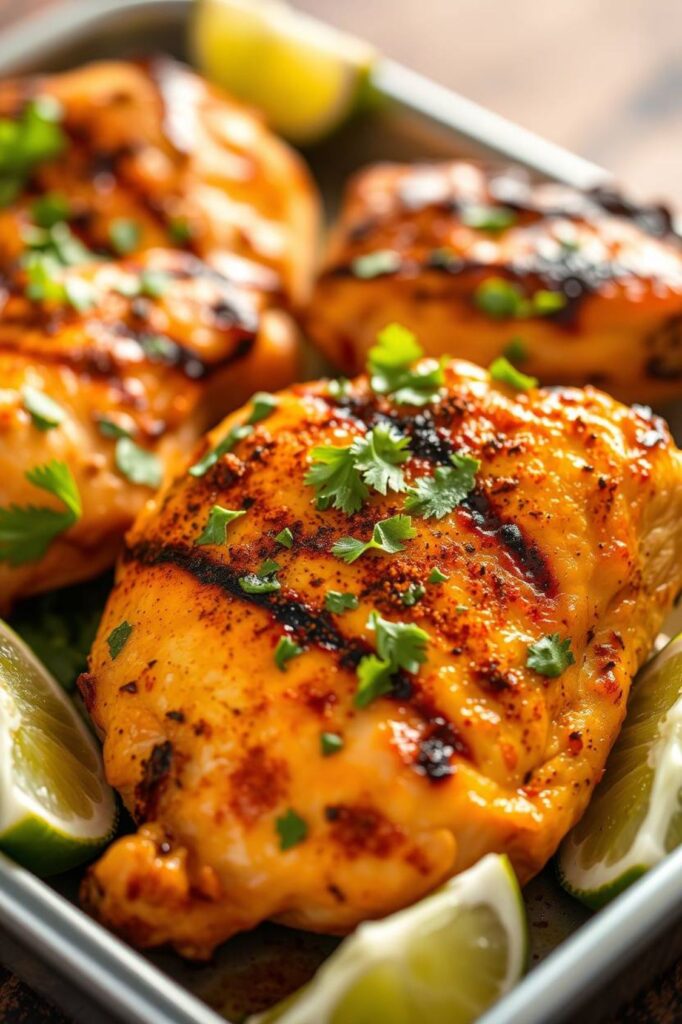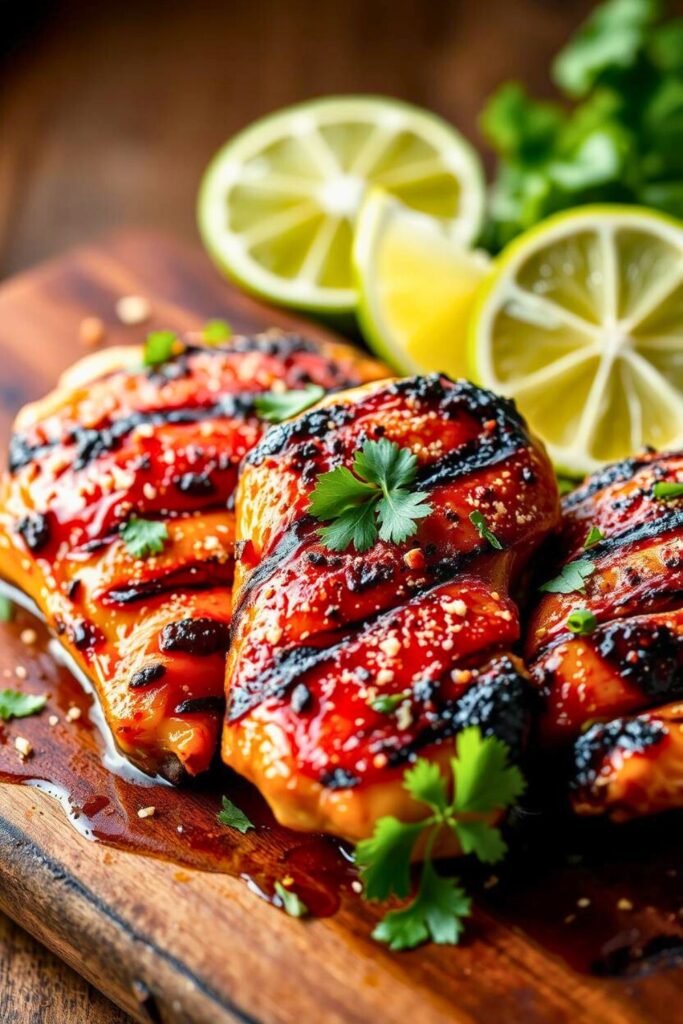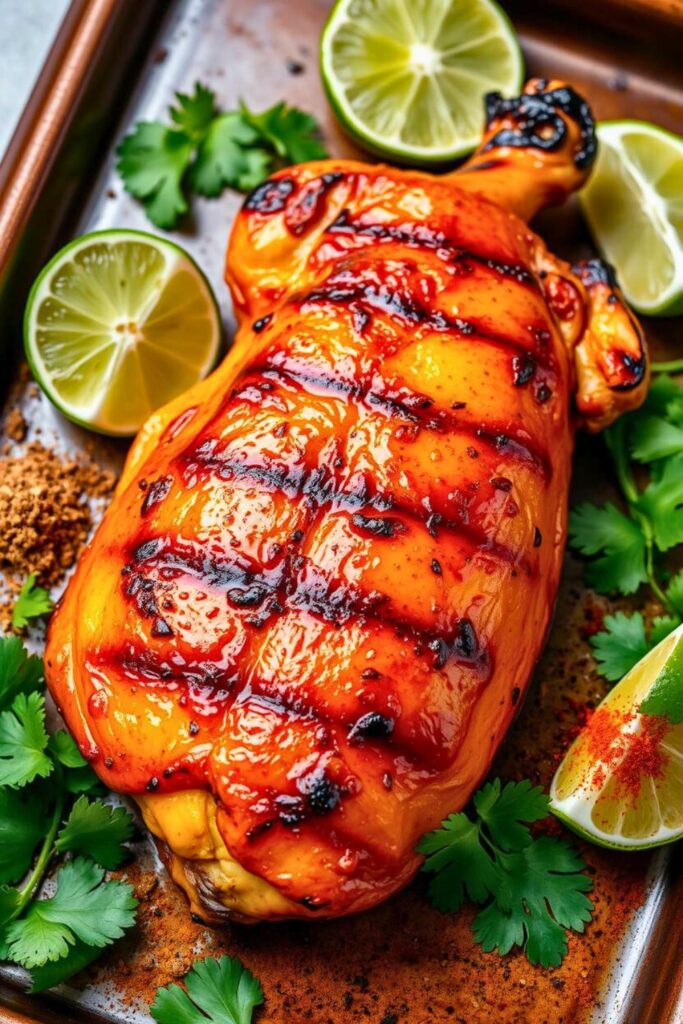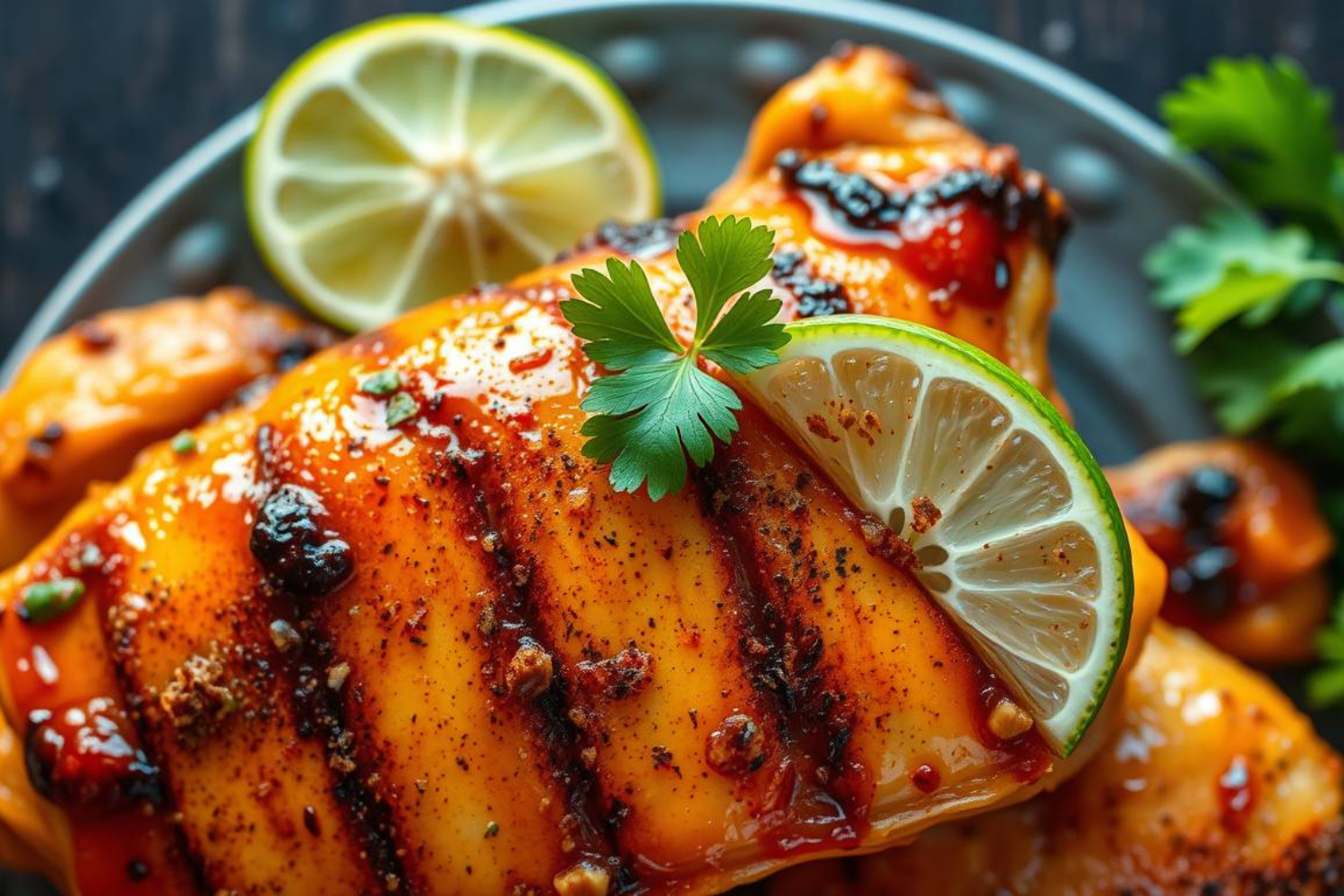Picture this: you walk into your neighbor’s backyard barbecue, and there’s this incredible aroma wafting through the air. It’s smoky, citrusy, with cumin and chili. That’s the magic of proper Mexican chicken marinade.
I’ll never forget when my friend Rosa taught me her family’s marinade recipe. We were prepping for her daughter’s Quinceañera, and she casually mentioned that the secret wasn’t just in the ingredients, it was understanding how each element plays its part. That conversation changed how I approach marinating chicken.
This marinade uses the holy trinity of Mexican flavors, citrus for brightness, chilies for depth, and aromatics that create incredible layers. This isn’t just about tenderizing meat (though it does that beautifully). It’s about creating chicken that tastes like the Mexican sun kissed it.
What sets this marinade apart from typical weeknight chicken? Balance. Fresh lime juice breaks down tough fibers while oil carries fat soluble flavors deep into the meat. Meanwhile, warm spices build complex flavor compounds that’ll have everyone asking for your secret.
Why This Mexican Chicken Marinade Changes Everything
Most people think marinating means soaking chicken and hoping. But real science happens in that bowl, and understanding it transforms your cooking.
Citrus acids work overtime, gently breaking down proteins to create melt in your mouth texture. Salt draws out moisture, then pulls all those incredible flavors back in. The flavors dance together in your fridge.
This blend uses traditional Mexican techniques perfected over generations. Dried chilies, fresh herbs, and citrus create “flavor layering.” Each taste builds on the next instead of competing.
The Perfect Mexican Chicken Marinade Formula
Most home cooks stumble on ratios. Too much acid makes chicken mushy. Not enough just coats the outside.
Here’s Rosa’s golden rule: for every pound of chicken, use 1/4 cup citrus juice, 2-3 tablespoons oil, and enough aromatics to make your kitchen smell like heaven. Balance creates the magic.
This marinade transforms any chicken cut beautifully. Thighs become incredibly succulent, breasts stay juicy instead of turning cardboard dry, and even tricky drumsticks cook evenly.
What You’ll Need

Let me walk you through this like we’re shopping together. I’ll tell you exactly what to look for and why each ingredient earns its spot. These bold Mexican marinade ingredients create layers of smoky, citrusy, and savory flavor that take your grilled chicken to the next level.
The Citrus Foundation
Fresh lime juice is non negotiable. Skip bottled juice, fresh limes taste completely different. You want 3-4 limes for a marinade serving 4-6 people.
Orange juice adds sweetness that balances lime’s tartness. Use fresh if possible, but quality bottled juice works too. Natural sugars help create gorgeous caramelized bits when you cook.
Some cooks add white vinegar for extra tang. I like it, but it’s not essential if your limes are bright and acidic.
Oil That Does Heavy Lifting
Neutral oil like vegetable or canola works best. You need something that won’t compete with bold flavors. Olive oil works, but skip extra virgin, save that for finishing dishes.
Oil isn’t just for moisture. It carries fat soluble compounds from spices directly into chicken. Think of it as flavor delivery.
Chili Power Players
This is where things get exciting. Chipotle peppers in adobo sauce bring smoke and heat perfectly balanced. If you can’t find them, dried chipotle powder works, but you’ll miss complex smokiness.
Ancho chili powder adds deep, raisin like sweetness. It’s milder than expected and creates incredible depth. Regular chili powder works in a pinch, but ancho is worth seeking out.
Fresh jalapeños or serranos bring bright heat. Remove seeds if you’re heat sensitive, but those little guys pack serious flavor beyond spice.
Aromatic All Stars
Fresh garlic, really fresh, not pre minced jar stuff. You want firm, aromatic garlic. Plan on 4-5 cloves for a full batch.
Cumin is absolutely essential. It adds earthy, warm notes that scream “Mexican food” to your taste buds. Buy whole seeds and toast them yourself if you’re feeling ambitious, the flavor difference is incredible.
Mexican oregano differs from regular oregano. It’s more floral, less aggressive. If you can’t find it, use half as much regular oregano.
Smart Swaps When You’re Stuck
Can’t find chipotle peppers for your Mexican chicken marinade? Mix regular chili powder with liquid smoke and smoked paprika. Not exactly the same, but it adds that smoky chili flavor close enough to work.
Out of fresh limes for the citrus marinade base? Lemon juice works, though the flavor shifts slightly. Add tiny bits of orange zest to bring back that bright citrus complexity so essential in Mexican style marinades.
No Mexican oregano in your spice rack? Mix regular oregano with marjoram. Or use a smaller amount of regular oregano and toss in a few fresh cilantro stems for an extra herbal kick.
Living somewhere without ancho chili powder? Mix paprika with cocoa powder (seriously!) for a similar earthy sweet chili profile that works wonders in authentic marinades.
Step by Step Mexican Chicken Marinade Mastery
Let’s get our hands dirty. Technique matters as much as ingredients here.
Building Flavor Layers
Start by toasting whole cumin seeds in a dry pan for 30 seconds. You’ll know they’re ready when they smell incredible and darken slightly. This step isn’t optional, toasted cumin tastes completely different from raw.
Grind those toasted seeds in a spice grinder or mortar and pestle. Fresh, ground cumin is like a different spice compared to pre ground stuff sitting in your cabinet.
If you’re using dried chilies, toast them too. Just 10-15 seconds per side in that same dry pan. Don’t let them burn, bitter chilies ruin everything.
The Blending Process
Combine citrus juices first. Lime, orange, maybe that vinegar splash if you’re using it. Whisk them together completely.
Add oil slowly while whisking. This creates temporary emulsion that helps everything coat chicken evenly. It’ll separate later, and that’s fine.
Now for aromatics. Mince garlic really fine, you don’t want big chunks that might burn when cooking. Mix in ground cumin, oregano, and chili powders.
Marinating Like a Pro
Here’s where people mess up: don’t just dump and mix. Coat every piece of chicken thoroughly, then massage marinade into the meat.
Use your hands for this part. Tongs don’t give you the same control, and you need to work marinade into all nooks and crannies. Get under any skin and into any scoring you’ve done.
Timing matters more than most people realize. Thirty minutes is absolute minimum, anything less just flavors the surface. Two to four hours is the sweet spot for most cuts. Overnight works great too, but don’t go longer than 24 hours or acid breaks down proteins too much.
Common Pitfalls (And How to Avoid Them)
Don’t use metal bowls. Acid reacts with metal, creating off flavors. Glass, ceramic, or food grade plastic only.
Never reuse marinade that touched raw chicken. I know it seems wasteful, but food safety isn’t negotiable. If you want serving sauce, set some marinade aside before it touches raw meat.
Temperature control is crucial. Always marinate in the refrigerator, never on the counter. Bacteria multiply fast at room temperature, especially in acidic environments.
The Science Behind This Mexican Chicken Marinade Magic

Understanding marination science makes you a better cook. Know why each step matters.
How Acids Transform Chicken
Citrus acids perform “denaturation.” They unravel protein structures that make meat tough, essentially pre cooking surface layers without heat. This is why marinated chicken feels tender even before it hits the pan.
Too much acid creates mushy, ceviche like texture. That’s why timing matters with acidic marinades.
Salt content (from added salt plus natural sodium in ingredients) pulls moisture out initially, then draws it back in with all those flavors. The chicken drinks up all that deliciousness.
Fat Soluble Flavor Science
Many spice compounds dissolve only in fat. That’s why oil in your marinade isn’t just for moisture, it extracts and carries flavors that water based liquids can’t touch.
Capsaicin from chilies, aromatic compounds from garlic and cumin, even citrus oils from lime zest, they all dissolve better in fat than water.
This is why letting your marinade sit for a few minutes before using helps. Those flavors need time to migrate into the oil phase.
Heat and Maillard Reactions
When you cook marinated chicken, sugars from citrus juice and added sweeteners create incredible browning through Maillard reactions. That’s where gorgeous caramelized edges come from.
Spices also contribute to browning, which is why properly marinated chicken gets beautiful color when you grill or pan sear it.
Making Your Mexican Chicken Marinade Shine
Presentation matters, even for marinated chicken. A few simple tricks make your results look restaurant worthy every time.
Cooking Techniques That Show Off the Marinade
Grilling is probably most popular, and for good reason. Marinade sugars caramelize beautifully over direct heat. Just watch for flare ups from dripping oil.
Pan searing works incredibly well too, especially if you don’t have outdoor space. Get that pan ripping hot before adding chicken, and don’t move it until you get proper browning.
Even oven roasting creates great results. Dry heat concentrates marinade flavors while keeping meat juicy.
Perfect Pairings
This marinated chicken practically begs for fresh accompaniments. Think pico de gallo, avocado crema, or simple lime wedges and fresh cilantro.
Rice and beans are classic for a reason, they provide neutral backdrop that lets bold marinade flavors shine. Mexican street corn (elotes) makes an incredible side dish too.
For drinks, anything citrus forward works beautifully. Margaritas, obviously, but also agua frescas or even sparkling water with lime.
Storage and Make Ahead Tips
This Mexican chicken marinade actually improves with time, so making it a day ahead works perfectly. Meal prep friendly and full of flavor, it stores well in the fridge and stays good for up to a week.
You can even freeze marinated chicken for up to three months. Just thaw it in the fridge overnight and cook as usual. The texture might shift slightly, but the bold, authentic Mexican flavor will still shine through.
Leftover cooked chicken keeps for 3–4 days refrigerated and reheats beautifully. Use marinated chicken for tacos, burrito bowls, or salads. Just slice it thin, dice it, or warm it gently in a skillet.
Mastering Your Mexican Chicken Marinade Variations

Once you’ve got basic technique down, there’s so much room to play. This is where cooking becomes truly creative and personal.
Regional Variations to Try
Yucatecan style marinades often include achiote paste, which adds incredible earthy orange flavor and gorgeous color. Just a tablespoon transforms the entire profile.
Oaxacan versions might include chocolate or coffee, which sounds weird but creates incredible depth. Start with just a teaspoon of instant coffee or cocoa powder.
Northern Mexican styles often feature more oregano and sometimes include beer instead of some citrus juice. Sugars in beer add great caramelization potential.
Heat Level Adjustments
Want it milder? Skip fresh chilies and use just a touch of mild chili powder. Smokiness from chipotle peppers isn’t necessarily hot, so you can still get complexity.
For serious heat lovers, add habanero or even ghost pepper. But be careful, these marinades get hotter as they sit, so start conservative.
Poblano peppers add great flavor with very little heat. Roast them first for even more complexity.
Troubleshooting Your Mexican Chicken Marinade
Even experienced cooks run into issues sometimes. Here’s how to fix the most common problems before they ruin dinner.
When Things Go Wrong
If your chicken comes out mushy, you probably marinated too long or used too much acid. Next time, cut citrus juice by half or reduce marinating time.
Tough, rubbery chicken usually means not enough acid or not enough time. But here’s a trick, you can salvage it by slicing very thin against the grain.
Bland results often come from not using enough salt or not balancing flavors properly. Taste your marinade before using it. It should be bold and well seasoned.
The beauty of this Mexican chicken marinade is how forgiving it is once you understand basics. Every batch teaches you something new, and pretty soon you’ll be creating variations that reflect your personal taste.
Remember, cooking is about more than following recipes. It’s about understanding ingredients, respecting techniques, and most importantly, sharing incredible food with people you care about. This marinade has the power to turn simple weeknight dinner into something special, something memorable.
So grab those limes, fire up your spice grinder, and get ready to create chicken that’ll have everyone asking for your secret. Because now you know, it’s not really a secret at all. It’s just good technique, quality ingredients, and a little culinary love.
FAQs about Mexican Chicken Marinade
How long should I marinate chicken in this Mexican marinade?
The sweet spot is 2-4 hours for most cuts. Thirty minutes is absolute minimum if you’re in a rush, but you won’t get full flavor penetration. Overnight works great too. Just don’t go longer than 24 hours or acids break down proteins too much, making texture mushy. Thinner cuts like cutlets need less time, while thicker pieces like whole thighs can handle longer marinating.
Can I use this marinade on other proteins besides chicken?
Absolutely! This marinade is incredible on pork, especially tenderloin or chops. Fish works too, but cut marinating time way down, 15-30 minutes max, or acids will essentially “cook” the fish like ceviche. Beef skirt steak loves this treatment, and it’s perfect for fajitas. Even firm vegetables like portobello mushrooms or eggplant benefit from a quick 30-minute soak.
What if I don’t have fresh citrus juice?
Fresh is always better, but quality bottled lime and orange juice work in a pinch. Just avoid stuff with added sugars or preservatives. If you’re using bottled juice, you might want to add a little extra because it’s usually less acidic than fresh. A splash of white vinegar can help boost acidity if needed.
My marinade seems too salty/spicy/acidic, can I fix it?
Totally fixable! If it’s too salty, add more citrus juice and oil to dilute. Too spicy? A bit of honey or brown sugar tames heat while adding great caramelization. Too acidic? More oil and a pinch of sugar help balance things out. Always taste your marinade before using it, it should be bold but balanced. Remember, it gets diluted by chicken juices anyway.
Is it safe to reuse marinade that touched raw chicken?
Never reuse marinade that contacted raw chicken, that’s a food safety no go. But here’s a pro tip: if you want marinade for serving as sauce, set some aside before it touches raw meat. You can also make a double batch, use half for marinating and reserve the other half for drizzling or serving alongside cooked chicken.

Swiftly Captions by Tina Smith — Quick, flavorful food recipes made simple, bringing fresh inspiration to your kitchen every day






